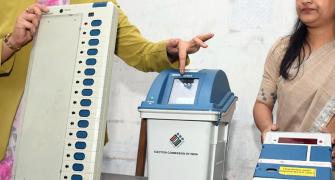Provision of safe drinking water is considered today as fundamental to good governance to promote good health and welfare of the people.
The states strive to resolve the issue involved in making safe drinking water accessible to all and to tackle the ever increasing concerns of depletion of ground water tables and quality problems that affect its sources. Considering the magnitude of the problem, the central government supplements the efforts of the state governments in this regard.
The Vice President of India Mohd Hamid Ansari has said that the last three decades have witnessed an impressive effort to provide access to safe drinking water to Indian households. It is heartening that while only 38 per cent of households had access to drinking water in 1981, that figure has gone up to 78 per cent by 2001.
Much of the progress has been in rural areas, with the number of households having access to drinking water going up from a mere 26 per cent in 1981 to 73 per cent in 2001.
Speaking on the occasion of the World Water Day 2008 organised by the Ministry of Water Resources, the Vice President said that this is a result of National Water Policy according the highest priority to drinking water in the planning and operation of the water resources system as also the success of the 'Accelerated Rural Water Supply Programme'.
He further added that the provision of sanitation facilities continues to remain a major challenge and an important Millennium Development Goal and only a third of our population has coverage with improved sanitation. This is far lower than the global coverage of 58 per cent, the developing countries' coverage of 49 per cent and even that of sub-Saharan Africa of 36 per cent.
Ansari said that ensuring rapid economic growth and undertaking targeted interventions have been the principle instruments in our poverty alleviation strategy. It is vital that our people have access to basic facilities including clean drinking water and improved sanitation for inclusive and sustainable growth.
This should not be seen nearly as essential public services from the welfare perspective, they are critical determinants of economic opportunities for our citizens and pre conditions for sustainable long-term growth. He said that water conservation and replenishment is increasingly assuming a global dimension.
Global warming and climate change have immediate and dire consequences for the availability of water. He hoped that the Government will continue to emphasise provision of safe drinking water and access to improved sanitation keeping in view the developmental, environmental and public health aspects.
Bharat Nirman
Drinking water supply is one of the six components of Bharat Nirman, which has been conceived as a plan to be implemented in four years, from 2005-06 to 2008-09 for building rural infrastructure.
Water Quality Affected Habitations
Rural drinking water supply is, to a large extent, dependent on ground water (85 per cent). Though ground water is less susceptible to pollution, the quality problem in ground water is inherent in the form of contamination caused by the very nature of geological formation, viz. excess fluoride, arsenic, brackishness, iron, etc.
The reasons for chemical and bacteriological contamination are: poor hygienic conditions around the water sources, improper disposal of sewage and industrial waste water, callous disposal of solid waste, indiscriminate use of chemical fertilizers having high quantity of Nitrates used in the agricultural sector, pollution from industrial effluents (untreated), over-exploitation leading to quality degradation, pollution of the source due to ignorance of the people, over-population and lack of public awareness.
The ground water level has depleted resulting in surfacing of quality problems due to higher concentration of the contaminants in the depleted sources of water. Inadequate recharging also aggravates the problem of chemical contamination.
Action Plan for Bharat Nirman
The states and union territories have been requested to furnish Action Plans along with list of habitations to be covered during the 4-year period of Bharat Nirman. This will facilitate preparation of a road map for achieving the goal set out under Bharat Nirman for rural drinking water supply by 2008-09.
Strategy
- Supplementing with new schemes for the habitations served by outlived schemes.
- Rejuvenation of the outlived schemes which are functioning below their rated capacity.
- Providing the regional schemes from alternative safe sources by extending new pipelines.
- Providing rainwater-harvesting structures.
- Reviving the traditional sources.
- Utilizing low cost technology for mitigation of quality affected habitations.
- Providing water supply from alternate sources for coverage of habitations with no safe source.
Sustainability of Rural Water Supply Sources
- For sustainability of systems, Department has undertaken extensive exercise for institutionalization of community participation in O&M of rural drinking water infrastructure.
- Low-cost technologies are being promoted not only for meeting drinking water requirements, but also for re-charging of the water table.
- Source strengthening measures proposed to be made an integral part of all Rural Water Supply schemes.
- Convergence of efforts of all Departments in watershed development and management would go a long way in meeting the drinking water needs.
Implementation Measures
- Intensive interaction with States for firming up the Action Plan for Bharat Nirman.
- Collecting Locational details, technology options and, fund requirement from States.
- Sorting out administrative and technical problems in poorly performing States on a case-to-case basis.
Commitment of States for providing matching or higher State share for coverage of NC / PC / quality affected habitations.
Focused funding for tackling water quality problems, particularly those relating to Arsenic / Fluoride / Salinity.
- Involvement of scientific institutions.
Monitoring
- Regular monitoring, concurrent evaluation / social audit of Bharat Nirman Drinking Water Schemes by lead NGOs / academic and research institutions, reputed social workers, professional experts.
- Taking feedback regarding implementation of the schemes from District Vigilance and Monitoring Committees which include elected representatives.
- Involving community and local institutions in water quality monitoring and surveillance.
Sustainability
Almost 85 per cent of the drinking water needs are met from ground water. Only 5 per cent of total groundwater extraction are used for domestic drinking water supply.
Irrigation accounts for 85 p of all groundwater extraction. The remaining 10 per cent of the ground water extraction is utilized by other sectors including industries. The rapid development of groundwater based irrigation in many States has caused ground water depletion. This affects the drinking water supply source adversely. Further, during summer months ground water depletion affects drinking water supply in rural areas.
It has been noticed that ground water depletion has aggravated water quality problems due to excess fluoride, arsenic and brackishness, in certain areas. This gets manifested in the form of various diseases like fluorosis and arsenical dermatitis, which has forced the state governments to abandon low-cost hand pumps preferring costly piped water supply schemes.
For the reasons stated above, there is a need to regulate the extraction of ground water. A model bill to regulate and control the development of ground water drafted by ministry of water resources has been circulated to all the state governments for enactment by their respective State Legislative Assemblies.
Further, the following action has also been taken by the Department of Drinking Water Supply to promote Rain Water Harvesting:
- Ministry of urban development has been requested to make rainwater-harvesting structures mandatory for urban constructions.
- Ministry of water resources has been requested to promote water-harvesting measures.
- All MPs have been requested to encourage/take up water harvesting schemes from their Local Area Development Fund.
- Technical Manual on Water Harvesting and Artificial Recharge has been finalised.
Different models of rainwater harvesting available in the country have been collected and a CD showing different models has been circulated to the States.
Water, the precious drop is the lifeline of human lives and the world needs to wake up to the ground reality that one day this nature's gift may dry up from this planet unless we take good care to nurture and replenish its sources.
Denizens of this planet also owe a duty to the Mother Earth. They must learn to use this life saving drop with great discretion, utmost caution and judiciousness. Promotions of water literacy among the masses is the need of hour. (PIB Features)
Courtesy: Press Information Bureau of India, Delhi







